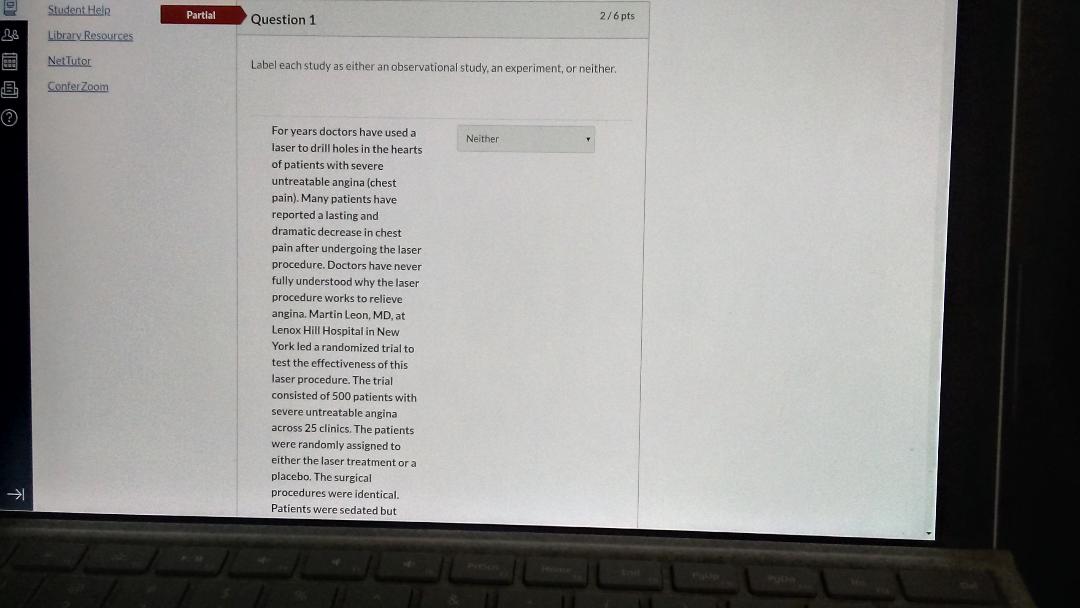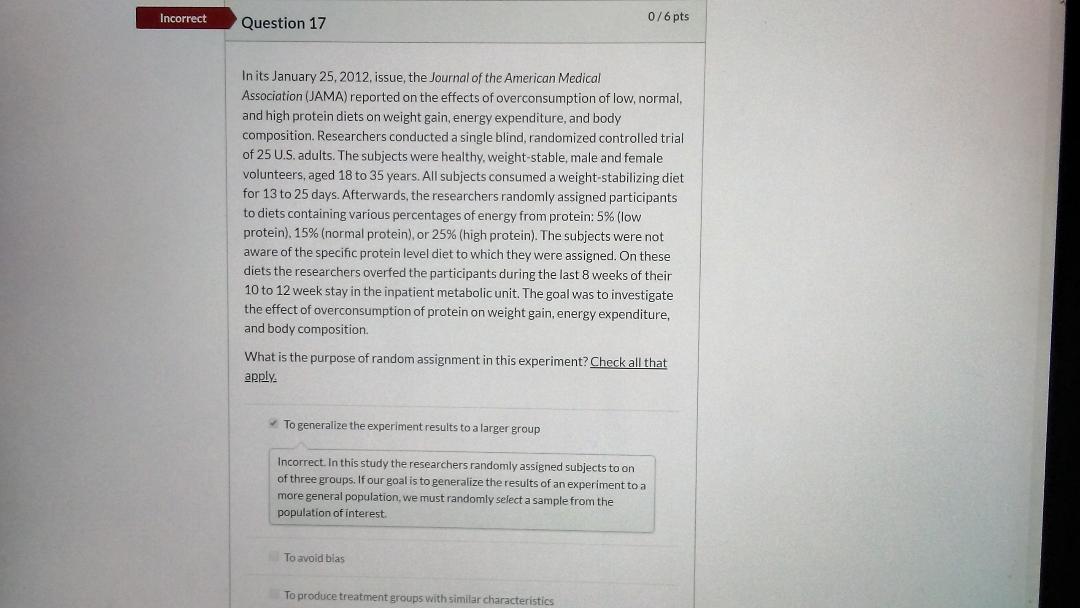C goved instructure com/courses/ 31685/quizzes/14561w/history version-1 O hear the surgeons discussing the laser process and see projections with elaborate 9 visual effects of the patient's heart. Each patient was convinced that the surgery was real. The placebo worked as well as the real laser procedure. "There was absolutely no difference," says (?) lead investigator Dr. Leon, Leon made his presentation at the Transcatheter Cardiovascular Therapeutics 2000 international meeting In this study, the researchers impose treatments on the subjects . the placebo surgery where no hole was drilled in the heart, or the laser surgery where a hole was drilled in the heart A 2007 U.S. study by Fontana. Klein, and Holloszy compared Experiment a number of factors associated with heart disease and metabolic disorders such as diabetes and blood pressure. Three groups of twenty-one participants in this study were matched for age, gender and other characteristics, The subjects in the raw vegan diet group were sedentary and had been eating a low-calorie, low- protein vegan diet composed primarily of unomarocend andStudent Help Partial Question 1 2/ 6 pts Library Resources NetTutor Label each study as either an observational study, an experiment, or neither. ConterZoom (?) For years doctors have used a Neither laser to drill holes in the hearts of patients with severe untreatable angina (chest pain). Many patients have reported a lasting and dramatic decrease in chest pain after undergoing the laser procedure. Doctors have never fully understood why the laser procedure works to relieve angina. Martin Leon, MD, at Lenox Hill Hospital in New York led a randomized trial to test the effectiveness of this laser procedure. The trial consisted of 500 patients with severe untreatable angina across 25 clinics, The patients were randomly assigned to either the laser treatment or a placebo. The surgical ->1 procedures were identical. Patients were sedated butD Question 17 6 pts In its January 25, 2012, issue, the Journal of the American Medical Association (JAMA) reported on the effects of overconsumption of low, normal, and high protein diets on weight gain, energy expenditure, and body composition. Researchers conducted a single blind, randomized controlled trial of 25 U.S. adults. The subjects were healthy, weight-stable, male and female volunteers, aged 18 to 35 years. All subjects consumed a weight-stabilizing diet for 13 to 25 days. Afterwards, the researchers randomly assigned participants to diets containing various percentages of energy from protein: 5% (low protein), 15% (normal protein), or 25% (high protein). The subjects were not aware of the specific protein level diet to which they were assigned. On these diets the researchers overfed the participants during the last 8 weeks of their 10 to 12 week stay in the inpatient metabolic unit. The goal was to investigate the effect of overconsumption of protein on weight gain, energy expenditure, and body composition. What is the purpose of random assignment in this experiment? Check all that apply. To generalize the experiment results to a larger group To avoid bias To produce treatment groups with similar characteristics To control for confounding variables Quiz saved at 1:53nnIncorrect Question 17 0/ 6 pts In its January 25, 2012, issue, the Journal of the American Medical Association (JAMA) reported on the effects of overconsumption of low, normal, and high protein diets on weight gain, energy expenditure, and body composition. Researchers conducted a single blind, randomized controlled trial of 25 U.S. adults. The subjects were healthy. weight-stable, male and female volunteers, aged 18 to 35 years. All subjects consumed a weight stabilizing diet for 13 to 25 days. Afterwards, the researchers randomly assigned participants to diets containing various percentages of energy from protein: 5% (low protein). 15% (normal protein), or 25% (high protein). The subjects were not aware of the specific protein level diet to which they were assigned. On these diets the researchers overfed the participants during the last 8 weeks of their 10 to 12 week stay in the inpatient metabolic unit. The goal was to investigate the effect of overconsumption of protein on weight gain, energy expenditure, and body composition. What is the purpose of random assignment in this experiment? Check all that apply. To generalize the experiment results to a larger group Incorrect. In this study the researchers randomly assigned subjects to on of three groups. If our goal is to generalize the results of an experiment to a more general population, we must randomly select a sample from the population of interest To avoid blas To produce treatment groups with similar characteristics










